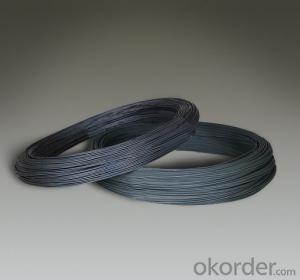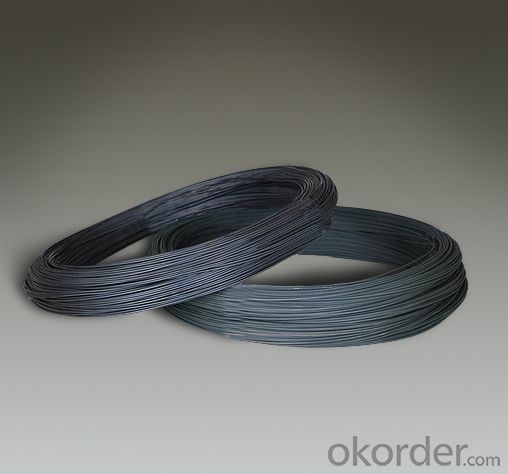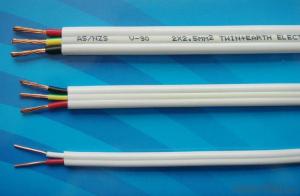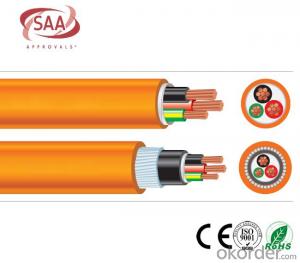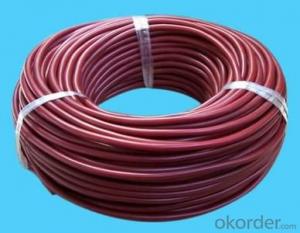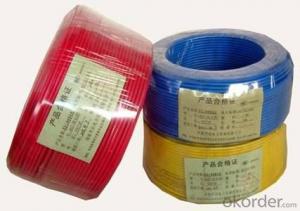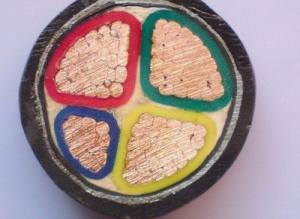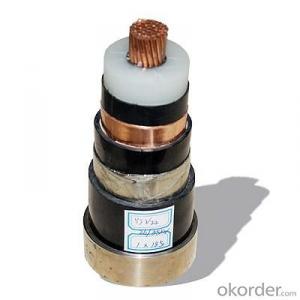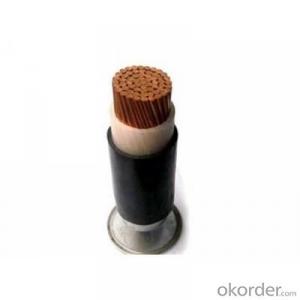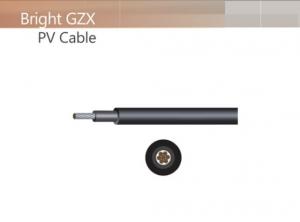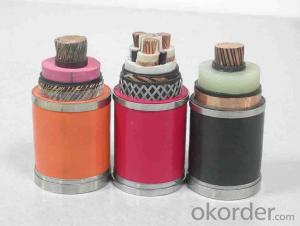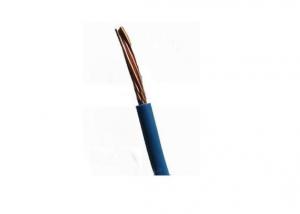Nicrosil-Nisil (Type N) thermocouple A quality
- Loading Port:
- Shanghai
- Payment Terms:
- TT OR LC
- Min Order Qty:
- 100000 m
- Supply Capability:
- 1000000 m/month
OKorder Service Pledge
OKorder Financial Service
You Might Also Like
1. WHY CHOOSE WISDOM NICR HIGH QUALITY THERMOCOUPLE ALLOYS?
All our raw material is made from prime material, not recycle material. We have more than 25 years experience in manufacturing thermocouple alloys.
In the market, not all the Thermocouple alloys are with standard chemical composition and stable EMF. Professional and reliable is the soul of our business.
2. DESCRIPTION OF THERMOCOUPLE ALLOYS:
A thermocouple is a temperature measuring device consisting of two conductors of dissimilar metals or alloys that are connected only at the ends. When the ends are at different temperatures a small voltage is produced in the wire that can be related directly to the temperature difference between the ends. If the temperature at one end is known, the temperature at the other end can be determined.
Thermocouple wire or extension grade wire is recommended to be used to connect thermocouples to the sensing or control instrumentation. The conditions of measurement determine the type of thermocouple wire and insulation to be used. Temperature range, environment, insulation requirements, response, and service life should be considered.
3. WISDOM THERMOCOUPLE ALLOYS CHARACTERISTICS:
1)Manufactured according to international quality. System (ISO9001) IEC584-1 IEC584-2 standard
2)Stable EMF and long-life span
3)Mill test certificate will be provided after production
4)Size range wire: . 0.05-10mm ribbons: 0.05-0.2*2-6mm strips: 0.05-5*5-250mm
5)Good packing methods to keep goods no damage during delivery
6)Customized lable, packing, OEM service
7)24 hours after-sale service
4. MAIN CHARACTERISTICS OF WISDOM THERMOCOUPLE ALLOYS
TYPE J (Iron vs Constantan) is used in vacuum, oxidizing, inert or reducing atmospheres. Iron element oxidizes rapidly at temperatures exceeding 538'C, and therefore heavier gauge wire is recommended for longer life at these temperatures.
TYPE K (CHROMEL vs ALUMEL ) is used in oxidizing, inert or dry reducing atmospheres. Exposure to vacuum limited to short time periods. Must be protected from sulfurous and marginally oxidizing atmospheres. Reliable and accurate at high temperatures.
TYPE T (Copper vs Constantan) is used or service in oxidizing, inert or reducing atmospheres or in vacuum. It is highly resistant to corrosion from atmospheric moisture and condensation and exhibits high stability at low temperatures. It is the only type with limits of error guaranteed for cryogenic temperatures.
TYPE E (CHROMEL vs Constantan) may be used in oxidizing, inert or dry reducing atmospheres, or for short periods of time under vacuum. Must be protected from sulfurous and marginally oxidizingatmospheres. Produces the highest EMF per degree o any standardized thermocouple.
Type N thermocouple (Ni Cr Si-Ni Si Mg) is the latest base metal thermocouple, developed to improve the drawbacks that type K thermocouple has. The main chemical composition of positive leg Nicrosil(NP) is Ni: Cr: Si≈ 84.4: 14.2: 1.4; Negative leg Nisil (NN) is Ni: Si: Mg≈ 95.5: 4.4: 0.1. Type N thermocouple also be used in the similar atmospheres that type K works, and the operating temperature range is -200~1300 ° C.
- Q: How the square of the cable and the current conversion
- Power cable, also known as power cable, refers to the transmission of electrical energy cable, the control cable is the transmission of various control signals cable
- Q: Does an air conditioner require several square wires? How many air conditioning is a tile?
- If the original line on the wall is installed with a switch, can not be replaced by a socket, because the switch is the two lines are FireWire. The socket requires a line of fire.
- Q: Hello.I switched over from a gas dryer to an electrical dryer in our home. I ran 10/3 wire from a dp 30A breaker to a 4-wire recaptacle for the dryer.When I turn on the dryer, she spins but no heat.When I checked the outlet, each hot wire to neutral gets 120 volts but between the two hot wires I do not get 240. I then went to the breaker and checked there. Once again 120 from each of the hot wires to neutral, but no 240 volt reading from one hot wire to another. What would be the problem?In fact, when I check any two hot wires on the breaker I do not get 240 volts. Why? I tried swapping out the 30 amp breaker for another one in the event that it was faulty, but alas, still no 240 volts.
- Check across the bus bar (where the breaker plugs in to the panel) see if it has 240 volts. This is the bar that the breaker plugs in to. If you do not have 240 volts across this then check the line side of the main breaker (where the wires terminate at) see if you have 240 volts across this. If you have 240 on the wires that attach to the main and do not have 240 across the bus bar you have a bad main breaker not giving you 240 volts. You may try to re set it and see if that does the trick. If you check the line side if the main and do not get 240 volts then you should cal an electrician Hope this helps
- Q: I have two 9 volt batteries, two 9 volt battery holders with a red and black wire coming from them, one switch with two prongs coming out of it and one light bulb. How can i arrange these items so i have two 9 volt batteries powering this one light bulb with a switch in the middle?
- If you are trying to power the bulb off of 9v that will last longer by having twice the batteries you would connect the two red wires and two black wires from the batteries together. Take a red to the switch and the black to the large base of the bulb. Take another piece of wire from your other side of switch to the pin on the bulb. You now have a 9v light that will last twice as long. If you bulb can handle 18v then you would connect a red from one battery to a black from the other. The black from the first battery to the base of the bulb and the red from the second battery to the switch. Now your extra piece of wire from the switch to the pin on the bulb. Only do this if your bulb is rated grater than 18v or you will burn the bulb. If you have an LED it will matter which direction you hook it up.
- Q: I was just doing some investigating to my home's electrical setup, on curiosity. I noticed that I have a room with two electric heat panels, each rated at 2548W. They are on 12AWG wire, and a 20A breaker. I did the math, and came up with a total current draw of 21.23A. How come my breaker isn't tripping? And is this a fire hazard?
- A household circuit breaker has a trip time characteristic that is a function of current. The higher the current, the faster it trips. A 20A breaker may well never trip at 21.23 A. There is considerable conservatism in the wire rating too. A 20A breaker is appropriate for 12 AWG wire per the National Electric Code. I do not think you are in danger. Also the heat panels presumably cycle on and off to maintain temperature so they are not continuously on. This will help the situation too.
- Q: I plugged in a computer to one of my outlets. I felt current passing through my band as I touched the case and held the monitor Connection and got a big spark when I tried to connect the monitor. This only happens on that outlet.
- You need an electrician to sort this out, as you have probably tripped the breaker or blown a fuse. You don't know enough to solve this if someone else wired the rest of the circuit wrong.
- Q: I have two electrical outlets in my bathroom, one feeds the other. They do not work.The lights work and the surrounding outlets work. I've checked every GFI outlet in my house but cannot find a source.
- the one that is out may have a built in breaker, check for a red button, and reset. or it may be on a seperate circuit, so check the fuse/breaker panel. hope this helps.
- Q: i have only three buttons, 2 light bulbs, and tons of wiresi need to make button #1 light up light #1and button #2 light up light #2and button #3 light up light #1 and 2thanks5 stars for correct working answer
- A C or D C?
- Q: I need help with simple electrical wiring, everything from where does the active and neutral go, in for example lights with a common, a loop, a one and a two. Possibly any links to EBook of useful websites. I am currently undergoing a pre-vocational course at tafe, just looking for a better understanding
- Pay attention in class and read the literature, that is much better than what I could put in a paragraph or two. If you have specific problems, then bring them up here or send email. .
- Q: I earlier posted this question and was told not to cover wiring as the wires could overheat, etc. So I was careful to lay out the rolled insulation away from wires.In the recent issue of Popular Mechanics there is a short article on blown insulation. Doesn't that cover just about everything in the attic?Now I am not sure what to do.Can the wires be covered or not?
- the perfect way is to diminish the insulation a foot longer than the area to the cord, then chop up the insulation so as that it is going above and below the cord. start up a clean piece of insulation tucked tight to the finest. in case you fill up the bays, and also you should use extra insulation bypass at proper attitude to the first layer.extra is extra positive
Send your message to us
Nicrosil-Nisil (Type N) thermocouple A quality
- Loading Port:
- Shanghai
- Payment Terms:
- TT OR LC
- Min Order Qty:
- 100000 m
- Supply Capability:
- 1000000 m/month
OKorder Service Pledge
OKorder Financial Service
Similar products
Hot products
Hot Searches
